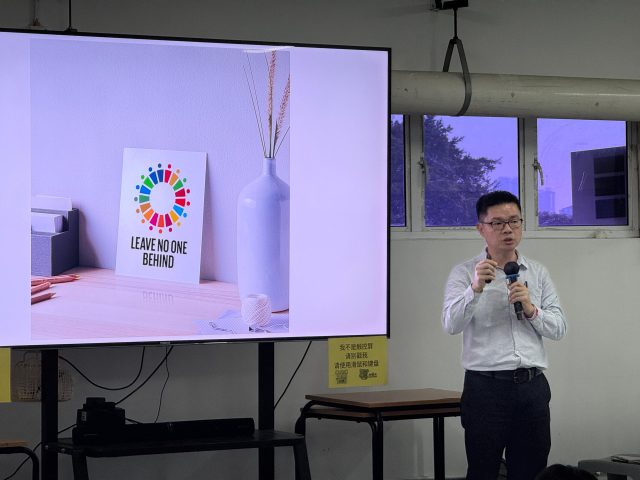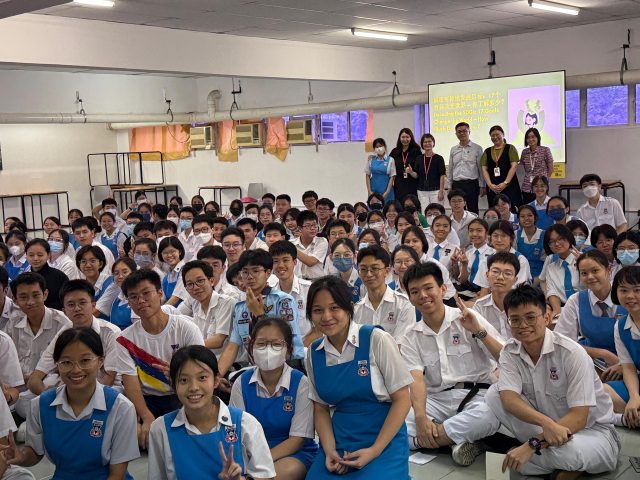Reported by:
Tan Ee Shieng Sr1ScB
Photography by:
Academic Department
The Sustainable Development Goals (SDGs), set by the United Nations, are global initiatives aimed at addressing pressing social, economic, and environmental challenges, fostering sustainable development worldwide. This urgent call to action has inspired researchers, activists, and educators alike. With the launching of the Inquiry-based Learning Project (IBL), a collaboration between Kuen Cheng High School and University of Tunku Abdul Rahman (UTAR), our students have been provided with more opportunities to unlock their academic potential and strengthen their personal character. A Talk titled “Decoding the SDGs: 17 Goals to Change the World – How Much Do You Know?” was held after school on 27th August 2025, aimed at enhancing the understanding of this topic.

(Photo 1: Dr. Lai Soon Onn, Associate Professor from UTAR advocating SDGs)
The students buzzed with excitement as they settled into their seats. Dr. Lai Soon Onn, the Associate Professor from UTAR Lee Kong Chian Faculty of Engineering & Science was invited to give the talk. Dr. Lai is very knowledgeable about environmental issues. He advocates for a greener, more sustainable future. He began by highlighting global warming, a pressing issue he believes attracts significant public attention. He shared an educational video showing the increase in pollution over the past century. Oil spills polluting the ocean, nuclear accidents harming humans’ health, rubbish piled up into mountains; as these phenomena become more prominent, it should be more appropriate to refer to “climate change” as “climate risk” nowadays.
Dr. Lai encouraged us to imagine a vibrant future and inspired us with thought-provoking questions. If these unsustainable practices continue, will our land be even more polluted? Will microplastics outnumber fishes in the ocean? Will we see more environmentally harmful technology? This is precisely why many countries are looking for sustainable energy alternatives. Dr. Lai gave an example of Sabah and Sarawak blazing the trail in promoting local green energy usage. A productive discussion was open to the floor, leading to active exchange of ideas.
As humanity and technology grow, problems are bound to arise. Dr. Lai explained that after the Industrial Revolution, environmental pollution and resource pollution has only gotten worse as people still stuck to the “take, make, dispose” method of traditional development. There was also an obvious gap in living standards and economy between developed countries and developing countries. Thus, SDGs and its 17 goals were designed in 2015 by the United Nations to tackle world problems from an environmental, social and economic perspective. Ultimately, the agenda is “peace and prosperity for the people and the planet”.
This rethinking process actually started from the Millennium Development Goals (MDGs) in 2000, which only had eight international development goals, as Dr. Lai elaborated. However, the MDGs only focused on certain issues and countries, proving to be insufficient as a “global” mission. These limitations lead to the SDGs being designed as its replacement and improvement.
Dr. Lai reiterated that the most important thing to remember about SDGs is “leave no one behind”. SDGs follow five core principles, namely People, Planet, Prosperity, Peace and Partnership (Five P’s). Dr. Lai mentioned that all 17 goals are interconnected and related to our daily lives, such as turning off the lights when unnecessary, which conserves energy and plays a small yet important role in boosting SDG 13: Climate Action.
He then proceeded to list numerous issues related to crucial SDGs and the innovative solutions. For instance, “We Care Solar Suitcase” was invented to reduce the number of deaths during labour caused by the lack of healthcare and electricity in Uganda, which coincides with SDG 3: Good Health and Wellbeing. On the topic of SDG 4: Quality Education, Dr. Lai mentioned Malala Yousafzai, an education activist, who courageously fought for women’s rights to education in Pakistan. Additionally, SDG 6: Clean Water and Sanitation proves vital as 40% of the human population is impacted by the lack of clean water. Dr. Lai also mentioned Greta Thunberg, a young climate and human rights activist who began advocating for the environment at the age of 15.
2024 has been designated the hottest year on record, and it’s possible that 2025 will surpass that mark. Dr. Lai urged students to take action as well, starting with small steps such as taking care of our own health, reducing plastic use and creating awareness about SDGs.
“Small hands change the world,” a warm encouragement from Dr. Lai before the end of his Talk. We should all contribute in protecting Mother Nature and building a better future. To conclude, what kind of future do you envision for the upcoming generations, and which role are you willing to take on?

